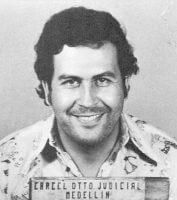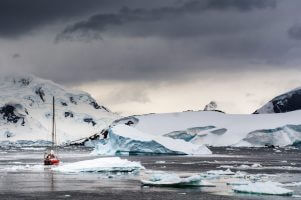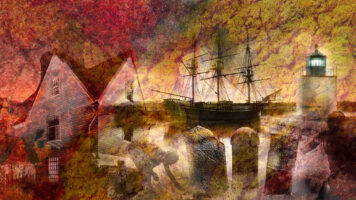Ad Free. Reader Funded.
Your contribution supports our partnership with the author of this piece. On top of their article pay, 50% of all contributions go directly to this journalist.
% of $ Goal
Total number of contributions so far:
0
Total amount raised for journalists
$0
“One thing I really appreciated about working with Hidden Compass is that it’s a space where there is time for nuance and complexity. By donating, that’s what you’re supporting. You’re able to help us as writers, but also as an outlet, continue to tell these kinds of stories.”
- Anna Polonyi, Hidden Compass Journalist
“The reason why I contributed was because the article that I read really resonated with what I was feeling. I felt like the author was in my head... It just moved me and I felt like I needed to do something.”
- Hidden Compass Reader
Its story begins more than 3,000 years ago in Tibet, tumbling along the ranges and foothills of the Himalayas, all the while bringing a ceaseless flow of vitality along its long and snaking path. Whole religions and civilizations spring from its sustenance.
On one particular stretch of riverbank, a singular culture is seeded. Over the course of centuries, this culture’s roots grow deep, too entangled with the earth to say precisely from where they originated. The people, too, become entwined with their remote home, forming a rigid belief system embedded in the sanctity of this pristine environment.
Of course, the glorification of purity rarely comes without complication. That tension drew me to a remote corner of the Trans-Himalayan frontier along the storied banks of the river Indus.
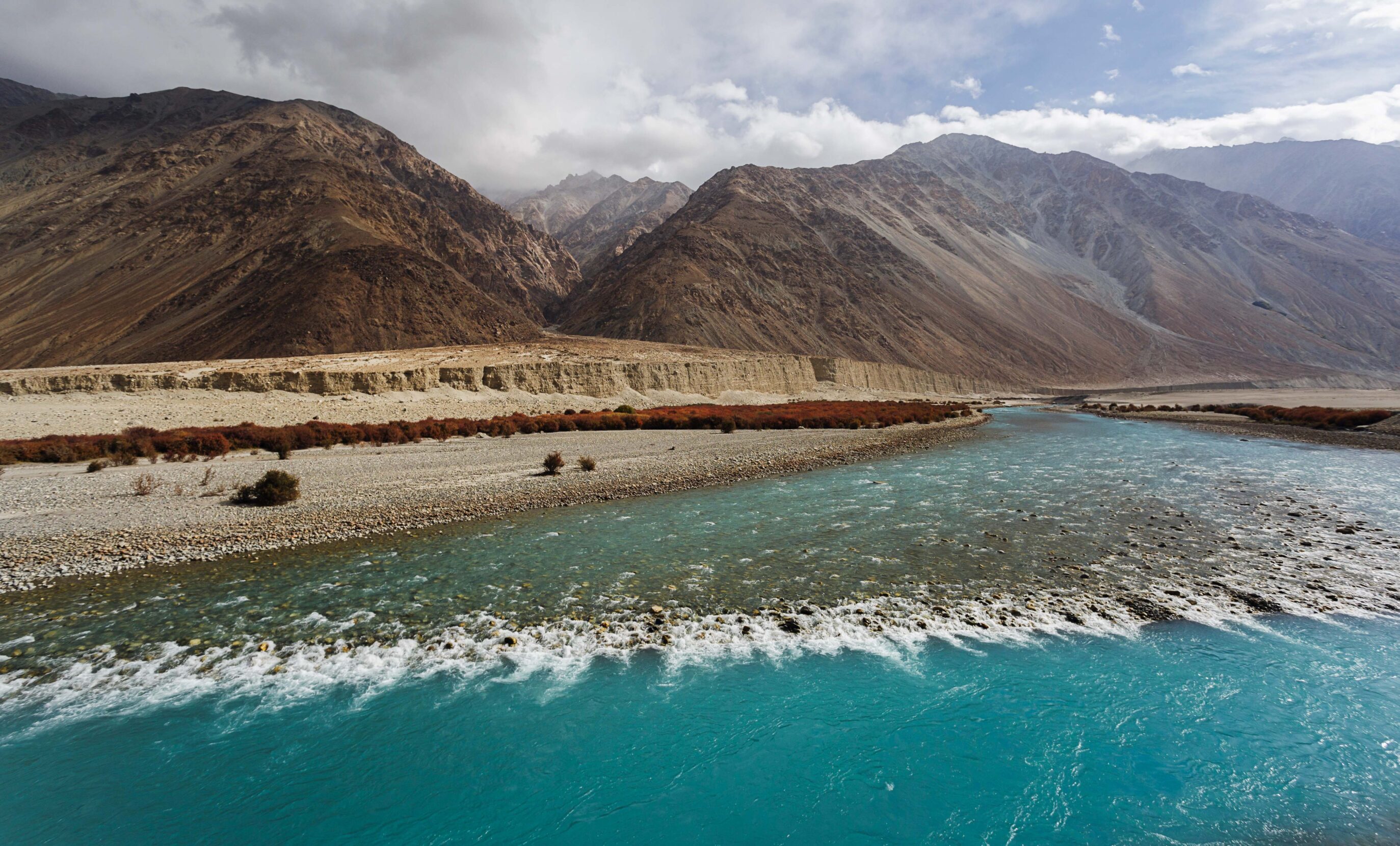
Rising from atop the so-called roof of the world, the Tibetan Plateau, the Indus River traverses nearly 2,000 miles. Among the world’s longest rivers, it features twice the annual flow of the Nile. Photo: Matjaz Corel / Alamy.
~~
Two men, neatly dressed in goncha — maroon robes fitted with broad cummerbunds — sat on the grass of the small courtyard. They quickly set up a pair of drums and a protracted wooden pipe with a bell-shaped outlet. I recognized the wind instrument as a surnai, a quintessential part of religious and social gatherings across the Ladakh plateau of India.
Clean, shrill notes pierce through the crisp mountain air, and the dance began.
A quartet of women wore long sheepskin robes over flowing silk dresses bedecked with shells, thickly braided threads, and a jangly assortment of silver and copper jewelry and old coins. Their long hair, worn in interlocked plaits, was crowned with an elaborate headpiece, called a tepi, abloom in brilliantly hued flowers. With a pair of men in maroon in the center of the circle, the group moved elegantly, delicately stomping their feet in rhythm with the beating of the drums. Every so often, the pace quickened as the two male dancers made sweeping hand movements and let out a high-pitched croon.
In the brief interludes when the music paused, I noted the sounds of the Indus, gushing past the narrow mountain road that separated the Biama village guesthouse where I was staying from the subcontinent’s mightiest waterway. A faint whiff of juniper, a Himalayan plant believed to cleanse environmental pollutants, wafted through the courtyard.
Seated beside me was my host, Skitzom. Her plump face animated, she whispered that the dance narrated the story of the origin of her people, the Brokpa. I sat up straighter, eager to absorb every detail.
Though only around 4,000 people make up this enigmatic civilization, legends about their heritage abound. The performance before me only added another wrinkle to the mystery that had brought me here, this litany celebrating the long-ago arrival of a trio of brothers that the Brokpa still herald as the first inhabitants of the valley.
Most of the Brokpa, until a generation ago, had never ventured out of this small stretch of the valley.
As the bright Ladakh sun gradually turned mellow, the shadows lengthening, the dance ended with a final flourish, the nasal notes of the surnai culminating in a crescendo. In the descending darkness, Skitzom served me and my fellow spectators a spread of tea and biscuits.
The tall and lanky man who had played the surnai approached me. Without preamble, speaking in Hindi with a slight lilt, he pronounced with pride: “We are Minaro.”
This word didn’t yet hold meaning to me, but, as I soon discovered, its implications are as foundational to Brokpa identity — and as far-reaching — as the great Indus itself.
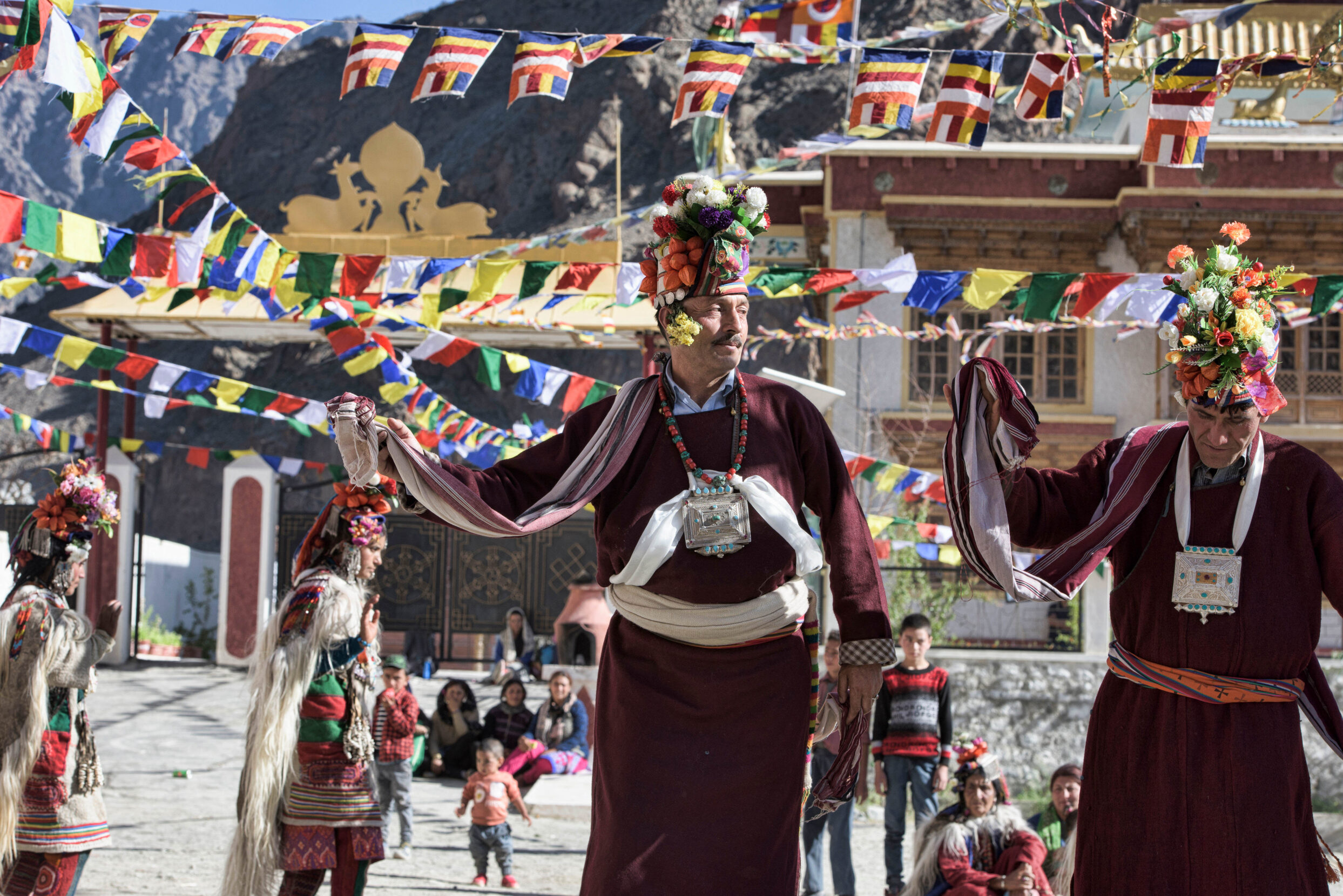
Brokpa men and women, dressed in traditional attire, perform a ceremonial dance in the village of Biama — one of five remote villages on the Ladakh plateau of India in which the entirety of this ancient civilization is clustered. Photo: Dave Stamboulis / Alamy.
~~
Upon my arrival earlier that afternoon, this deep and narrow valley had felt like an oasis after the cold, barren desertscape of the five-and-a-half-hour drive from Leh, itself some 1,500 miles from my home in Kolkata. Steep, rugged mountains rose abruptly from the Indus. Scattered around were mud-and-stone, rough-edged dwellings precariously perched on the edge of the craggy cliffs. In the middle of that inhospitable terrain, terraced farmlands of buckwheat, barley, and millet created an abundant, checkered canvas in the shadow of flowering groves of walnuts, apples, and apricots.
As my driver, Ahmed, had negotiated the strip of tract that sliced through the northern bank of the Indus, he offered commentary in Hindi: “Possibly the fertility of the valley attracted the earliest settlers.”
The socio-religious belief system of the Brokpa is heavily invested in the concept of pollution and steering clear of contamination.
The entirety of the Brokpa civilization inhabits five small villages — Hanu, Dha, Biama, Garkhun and Darchik — clustered along a 25-mile stretch of valley near a highly sensitive border between India and Pakistan. Skirmishes in this mountainous zone are frequent, having culminated in a full-blown war between the two countries in 1999.
Expertly swerving past a convoy of military trucks, Ahmed announced our arrival with a provocative declaration: “We are now entering Aryan Valley.”
~~
My guide, Dolma, seemed to know everyone in the village. “The residents of the five villages are members of an extended family, interconnected through generations of marriages,” she explained. Near Skitzom’s guesthouse, on the steps of a staircase that led to the upper reaches of the settlement, we ran into Nirma. The two women — childhood friends — embraced.
With their large almond-shaped eyes, high cheekbones, and chiseled facial characteristics — markedly different from the smaller eyes and flatter faces more typical of the Ladakhis — they could pass off as two intrepid backpackers from Eastern Europe. Clad in a loose-fitting cardigan and blue jeans, Dolma fit the part, but the floral headgear on Nirma’s head distinguished her Brokpa identity.
As I took in her traditional attire, my mind returned to the dance performance on my first evening here — and the words of the lanky musician.
Just before leaving, he had adjusted the bright orange flower dangling on his forehead and repeated his intriguing initial words: “We are Minaro.”
~~
Dolma led me to a small, vacant plot. Ritual objects such as horns of ibex, goats, and sheep lay strewn along a thick white slab of stone — the ancient place of worship for the Brokpa. A couple hundred meters away, a signboard indicated that the scattered heap of stones on a millet patch was actually the ruins of a three-story fortress. At some point in time, an entire village had lived under one roof here.
“In the Brokpa villages, strangers were and are not welcome,” wrote Veena Bhasin, retired professor of anthropology at the University of Delhi, in her 2017 research article that explores how the socio-religious belief system of the Brokpa is heavily invested in the concept of pollution and steering clear of contamination. “For Brokpa ethnicity is the only form of defining status,” Bhasin wrote.
Combined with the fact that the terrain was almost inaccessible for centuries, these villages had historically been off-limits to outsiders. But recent decades have brought better infrastructure to the region.
In my experience here as a visitor, my open curiosity and respect were greeted warmly. Attempts at further inroads, however, seemed to bring out a distinct standoffishness.
Most of the Brokpa, until a generation ago, had never ventured out of this small stretch of the valley. All the marriages, as Dolma had emphasized, happened within the community.
There was a word in the Brokpa language for this custom, one I had learned on my first evening here.
Minaro. Purebred.
~~
Though only around 4,000 people make up this enigmatic civilization, legends about their heritage abound.
In 326 B.C.E., Alexander the Great’s army retreated through this valley after the Macedonian warlord’s largely unsuccessful expedition to conquer the Indian subcontinent. Exhausted by years of relentless warfare, his army refused to continue with the campaign. When Alexander relented and began the long and perilous journey home, he left some of his soldiers behind.
Legend holds that the descendants of those Greek soldiers, who had stayed back and made this fertile river valley their new home, persist as an isolated micro-civilization. Though the claim that this is how the Brokpa people came to be is not corroborated by genetic evidence, ancient rumors of this “Aryan” distinction persist.
~~
The unpaved village street took us past patches of barley fields, apricot groves, and overgrown hedges to the mud-and-rock homestead of Sonam Norphel. With a wrinkled face and a beaming smile, the septuagenarian shoemaker sported a bright orange flower on his head that resembled a wood rose. He graciously greeted us and offered us butter tea as we settled on a sheepskin rug in his spacious kitchen — a dark, rectangular space dominated by an enormous cupboard full of pots and pans.
I asked Norphel about the valley’s first inhabitants. He had no idea about the specific timeline but echoed the narrative I had learned from the ceremonial dance: Centuries ago, three brothers named Dulo, Melo, and Galo had arrived here from the ancient region of Gilgit-Baltistan, navigating treacherous terrain to find their way downstream the Indus to this fertile valley. This same lore is played out every October in the triennial Bono-na festival, a thanksgiving ceremony to the gods for good harvest and prosperity.
If details of Brokpa origins have something of an amorphous quality to them, their cultural mythology is anything but, as a middle-aged Brokpa woman named Diskit was eager to explain at my next stop.
“Every part of our traditional dress has a significance,” Diskit said, seated on an elevated stone slab in the middle of the Aryan Valley Museum adjacent to her home in Garkhun village. The dimly lit interiors looked like a time capsule with its collection of traditional pottery, crude weaponry, and frayed dress materials that were collected from individual households in the villages. The preservation of culture here was meticulous.
With her aquiline face and voluminous, bejeweled gown, Diskit looked every bit an integral part of this antiquated mishmash, especially with the tepi — the signature Brokpa cap embellished with colorful flowers and accessorized with an assortment of needles and ribbons. Showing us through the collection, she explained how each detail adhered to her culture’s devotion to purity.
“We believe metals prevent sickness; the colorful silk ribbons help to configure planetary influences favorably,” Diskit said.
For at least 2,000 years, the predominantly Buddhist Brokpa maintained a strict vegan diet, an outgrowth of their worship of nature — and their aversion to contamination of any kind. Juniper is burned in ritual fumigation to cleanse the air.
“And this one protects us from the evil eye,” Diskit concluded, pointing with a flourish to her headgear, the vibrant flowers radiant in the murky darkness.
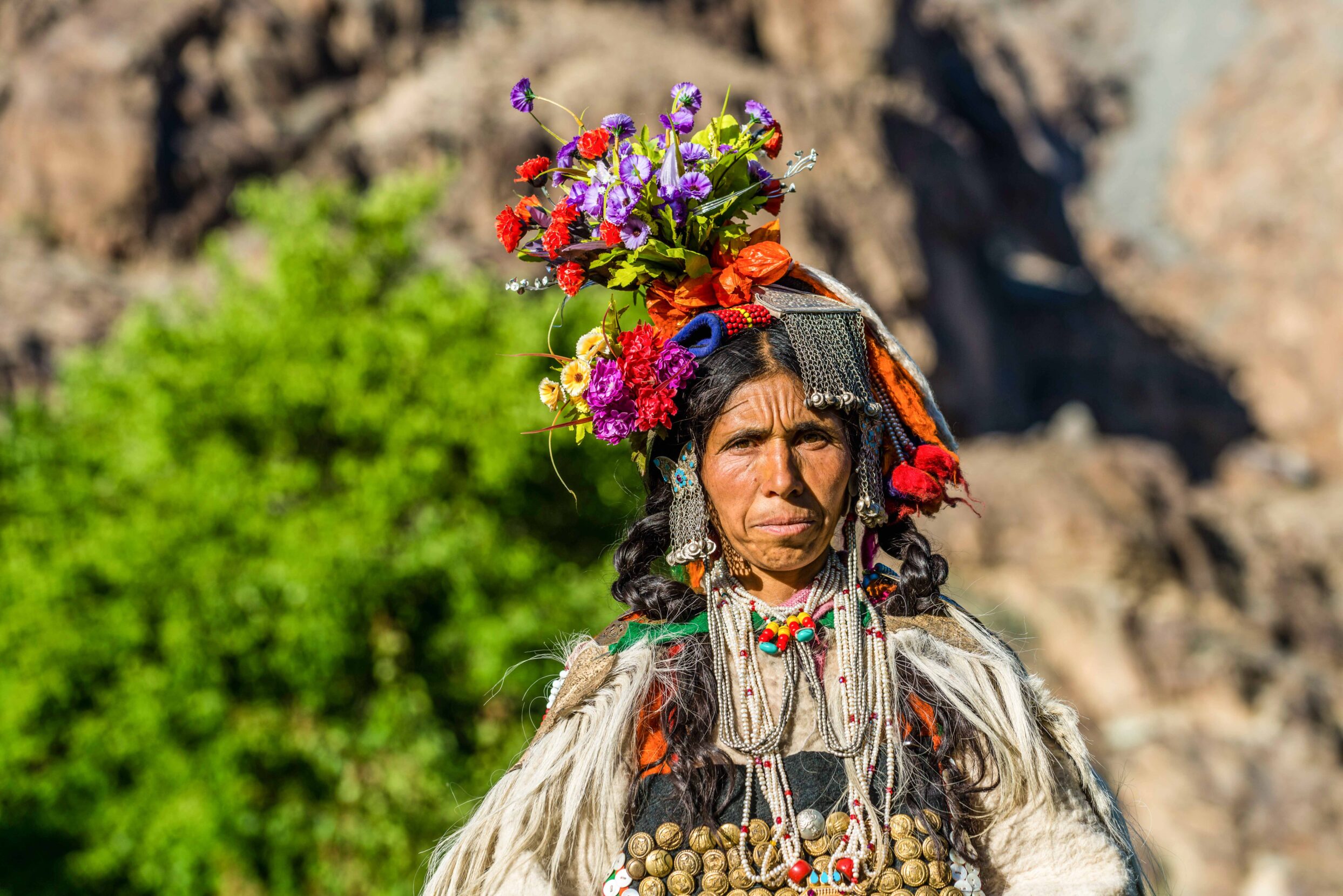
With the colorful tepi headpiece as its crown jewel, each element of the traditional Brokpa costume serves the culture’s devotion to purity. Photo: Frank Bienewald / Alamy.
~~
When Godfrey Thomas Vigne, an intrepid British explorer, traveled to these Brokpa villages in the 1830s, he found the inhabitants possessing European features — fair complexions, blue eyes, blond hair. He put forward the theory that these people were either direct descendants of Alexander’s Greek army or belonged to the theoretical original Aryan race from which all Indo-European people descended.
Mona Bhan, professor of anthropology at Syracuse University, says the stamp of “pure Aryan stock” here is a legacy of the British rule — one deeply invested in racial categorization to further their colonial ambitions on the Indian subcontinent.
The early orientalist scholars were also influenced by the famous theory of two Aryan races by acclaimed German linguist Max Müller. He built his hypothesis of an Aryan invasion of India’s Indus River valley on the basis of resemblances in the linguistic approach between the ancient Indian language of Sanskrit and the European languages of Greek and German.
His work would eventually be distorted to further racist ideology, pitting Indo-European traditions against Semitic religions, culminating in the atrocities of Aryan supremacy under Nazi rule.
In Sanskrit, the word Arya translates to “noble.” And in an increasingly syncretic world, a troubling Aryan mythology persists.
~~
Of course, the glorification of purity rarely comes without complication.
Film footage shows a German woman and a Brokpa man, their identifying features blurred. The pair had based themselves in a Leh hotel — a temporary liaison made to accommodate the lady’s mission to bear racially “pure” Aryan progeny. The scene appears in documentarian Sanjeev Sivan’s 2007 film, Achtung Baby: In Search of Purity.
The woman, who chose to remain anonymous, agreed to an interview with Sivan. Her face obscured, she hinted at an organized system that had long been operative to facilitate “birth tourism” in this corner of India, though she did not elaborate further. Her Brokpa partner, Tsewang Lhundup, a married man with children from Darchik village, was more candid about the liaison and expressed happiness with the financial arrangement.
Fifteen years after the film was made, I found the Brokpa reticent about this controversial issue. Sonam Norphel chuckled and shook his head when I asked him about it, and Dolma said that though she had heard about such propositions, she did not know any Brokpa man who had experienced such engagements.
In Darchik, the elderly Brokpa offered me freshly picked apricots from their kitchen garden and invited me into their homes for rounds of butter tea. Yet, on the topic of where Tsewang Lhundup lived, no one seemed interested in helping me.
Whether or not the valley is a hotbed for “pregnancy tourism,” as the trend has also been coined, the place has indisputably opened up to outsiders in recent decades.
As word of the Brokpa — their elaborate headgear, unique customs, and, perhaps above all, their fabled ancestry — has spread among intrepid travelers, a nascent tourism industry has started to germinate. The Brokpa, generally speaking, stick to their traditional origin story while at the same time embracing this welcome source of income.
In effect, their strict adherence to tradition, which naturally plays into the narrative that has garnered them fame, has become an asset in a globalizing world.
~~
I saw middle-aged Brokpa women working in barley fields while elderly ladies kept busy extracting apricot oil on their sunny terrace, most looking straight out of a period piece with their sartorial singularity. But the young members of the clan, I noted, mostly wore contemporary outfits.
Dolma’s jeans drew flak from the elderly Brokpa, either with nods of disapproval or with verbal admonitions. Dolma laughed it off when I questioned her about this.
“Of course, my friends and I love to wear the tepi, the traditional finery, and the flowing robes during festive celebrations. But as daily wear, they are too heavy,” she said, grinning.
More than attire is evolving with the times. Major road projects have been launched in Ladakh to improve inter-valley connectivity. Farther upstream, giant electric towers dotted the wind-blown, primeval landscape of this ancient valley.
The musician at Skitzom’s guesthouse had told me how members of the Brokpa community, men and women alike, are directly engaged in these development projects as construction workers and overseers.
He sounded happy about this new source of income, a supplement to their traditional source of revenue, which is dwindling as their fruits and other crops become less abundant. Climate patterns are changing even in these high Himalayas, with warmer winters and longer summers. Lately, some members of the community have begun incorporating meat and dairy into their diets, both as a result of a drop in agricultural yield and an increase in migration and outside influence.
A next-generation Brokpa, Dolma had recently completed a master’s degree in economics from a university in Dehradun. I asked her how she thought her parents would react if she were to marry outside the community.
Her response astonished me.
“They won’t be happy, of course,” she replied before adding, “but if I can’t convince them, I will still go forward with my decision.”
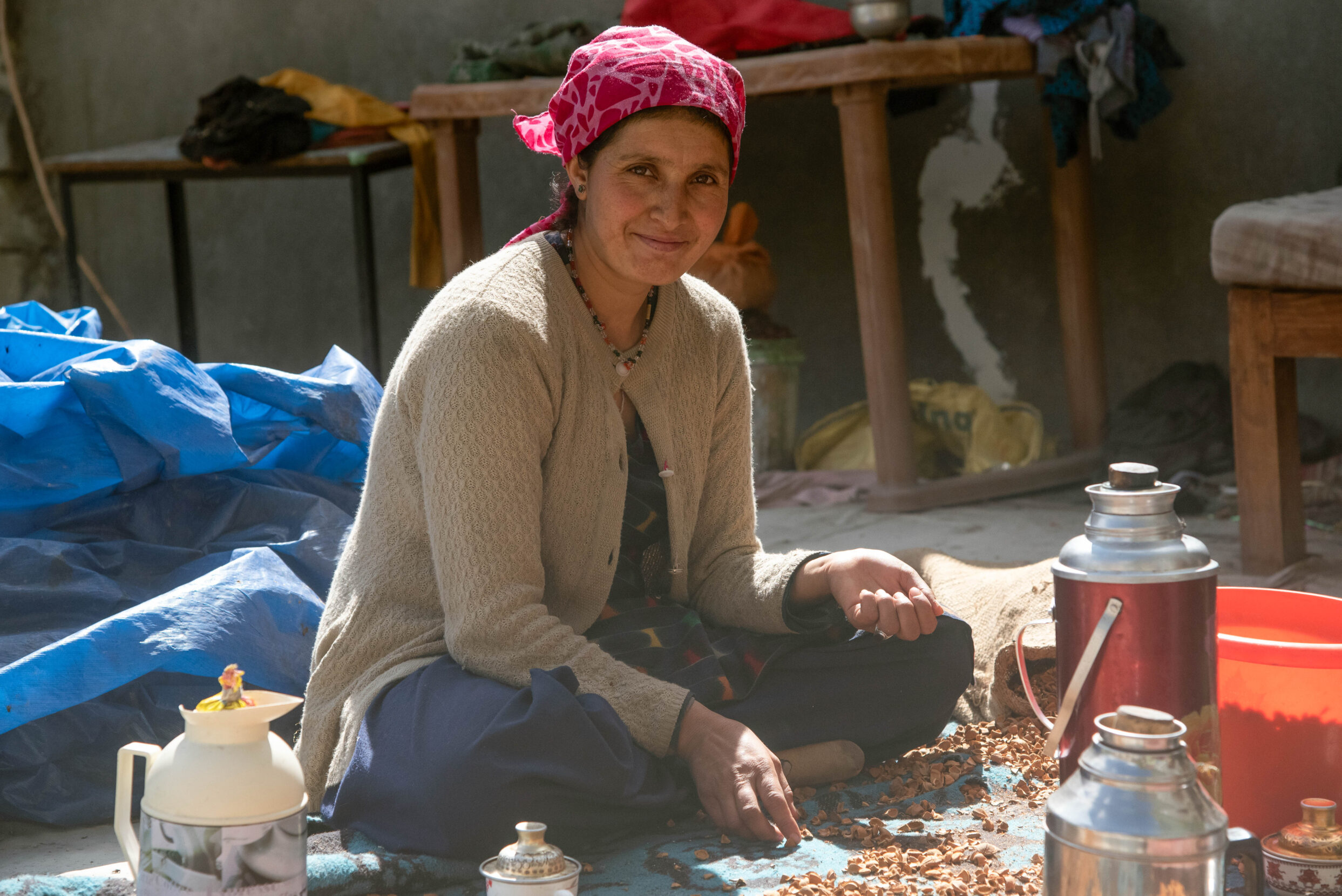
A Brokpa woman sits in the sun extracting the oil from apricots, a locally abundant crop famous for its remarkable sweetness. Photo: Sugato Mukherjee.
~~
In the late afternoon, Dolma took me to a white-and-gold monastery perched on the upper reaches of Biama village. This was the central place of worship for the Buddhist Brokpa.
“The views from here are excellent,” Dolma said, pointing to a corner of the expansive terrace that ringed the monastery.
I looked down — a sharp, precipitous drop of a few hundred feet where the cliff met the Indus. At a distance, I could spot smoke billowing from construction pits on the banks of the river, shadowy figures moving in and out of the gray-white smoke.
As the bright Ladakh sun gradually turned mellow, the shadows lengthening, the dance ended with a final flourish, the nasal notes of the surnai culminating in a crescendo.
Darkness began to gently fall. My gaze settled on the river, roaring through the valley the same as ever before.
The Aryan Valley stands at a crossroads, at once clinging to its past and reaching for novel opportunities. Among Dolma and her peers, I could sense a growing eagerness to break out of the confines of isolation. The precariousness of their culture, with its dedication to purity, was palpable.
Paradoxically, though, spending time amid the Brokpa had helped clarify a deeper truth. Purity is rarely more than a veneer. Staying in one place, untarnished by the natural flow of change, has always been a fallacy.
Their original lifeline, the Indus, serves as a demonstrative example. History shows that the switchback-laden river has been shifting course since, literally, the dawn of civilization — just as beholden to outside forces as anything blossoming along its banks.
Sugato Mukherjee
Sugato Mukherjee is a Kolkata, India-based photographer and writer whose work on the sulfur miners of East Java was recognized by UNESCO.
Never miss a story
Subscribe for new issue alerts.
By submitting this form, you consent to receive updates from Hidden Compass regarding new issues and other ongoing promotions such as workshop opportunities. Please refer to our Privacy Policy for more information.

